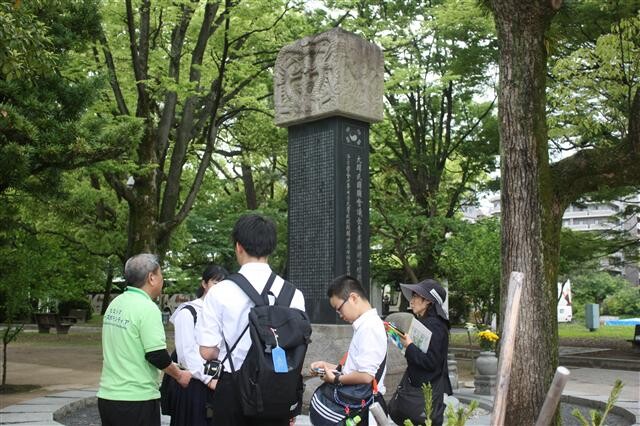hankyoreh
Links to other country sites 다른 나라 사이트 링크
The sad history of the memorial stone to Korean victims in Hiroshima Peace Park

Following Barack Obama’s decision to visit Hiroshima on May 27 to see the city where the first atomic bomb was dropped, there is growing interest about whether he will also lay a wreath in front of a memorial stone for Korean victims of the bomb in the Hiroshima Peace Memorial Park.
The US and Japanese governments have yet to announce the detailed itinerary of Obama’s visit to Hiroshima and say that nothing has been determined yet. It seems likely that Obama will tour the Hiroshima Peace Memorial Museum, which depicts how the bomb laid waste to Hiroshima, and then place some flowers in front of a memorial stone to those killed in the atomic blast, just as US Secretary of State John Kerry did on Apr. 11.
The question for South Korea, however, is whether Obama will also visit a memorial stone for Koreans, which is a two- or three-minute walk to the northwest of the main memorial.
The memorial stone for Koreans in the park is connected with two historical tragedies that the Korean people have had to endure.
The first tragedy was the death of Yi Wu (1912-1945), a member of the Joseon royal family who was killed in the atomic blast. The second son of Yi Kang (the stepbrother of Yi Un, the Joseon Dynasty’s last crown prince), Yi Wu was a lieutenant colonel in Japan’s Second General Army, serving as educational staff, when the bomb was dropped on Hiroshima. Injured in the bombing, Yi was found on the afternoon of Aug. 6, 1945, beneath the Aioi Bridge on the Hongawa River, near ground zero. He died the following day.
Unlike Yi Un, who collaborated with Japan, Yi Kang (1877-1955) never fell for the cajoling of the Japanese government. After Korea came under Japanese colonial control, Yi Kang secretly supported the independence movement and explored the option of escaping to the provisional government in Shanghai.
In 1967, a group of Korean-Japanese living in Hiroshima – backed by atomic bomb survivors and Mindan (Korean Residents Union in Japan) – began laying plans to erect a memorial stone for Korean victims of the bomb in the Hiroshima Peace Memorial Park. While the city of Hiroshima had responded positively to the idea at first, it soon adopted the position that it would not allow the memorial stone to be erected.
The discrimination and exclusion that Korean-Japanese had to endure in Japanese society was the second tragedy. The memorial committee had no choice but to set up the memorial stone outside the park, near the site where Yi Wu’s injured body was found.
Thanks to subsequent efforts by Japanese civic groups to bring attention to Korean and Korean-Japanese victims of the atomic bomb, the memorial stone was moved to its current location inside the park in May 1999.
“Toward the end of the war, around 100,000 Koreans were living in Hiroshima as soldiers, civilians working for the army, conscripted workers, mobilized students and ordinary citizens. When the atomic bomb was dropped, the precious lives of around 20,000 Koreans were instantly snuffed out,” the inscription on the memorial stone says.
It is estimated that from 20,000 to 30,000 people from the Korean peninsula (including both North and South Korea) lost their lives in the atomic bombing of Hiroshima, around 10% of the total number of those killed.
By Gil Yun-hyung, Tokyo correspondent
Please direct questions or comments to [english@hani.co.kr]

Editorial・opinion
![[Editorial] Does Yoon think the Korean public is wrong? [Editorial] Does Yoon think the Korean public is wrong?](https://flexible.img.hani.co.kr/flexible/normal/500/300/imgdb/original/2024/0417/8517133419684774.jpg) [Editorial] Does Yoon think the Korean public is wrong?
[Editorial] Does Yoon think the Korean public is wrong?![[Editorial] As it bolsters its alliance with US, Japan must be accountable for past [Editorial] As it bolsters its alliance with US, Japan must be accountable for past](https://flexible.img.hani.co.kr/flexible/normal/500/300/imgdb/original/2024/0417/6817133413968321.jpg) [Editorial] As it bolsters its alliance with US, Japan must be accountable for past
[Editorial] As it bolsters its alliance with US, Japan must be accountable for past- [Guest essay] Amending the Constitution is Yoon’s key to leaving office in public’s good graces
- [Editorial] 10 years on, lessons of Sewol tragedy must never be forgotten
- [Column] A death blow to Korea’s prosecutor politics
- [Correspondent’s column] The US and the end of Japanese pacifism
- [Guest essay] How Korea turned its trainee doctors into monsters
- [Guest essay] As someone who helped forge Seoul-Moscow ties, their status today troubles me
- [Editorial] Koreans sent a loud and clear message to Yoon
- [Column] In Korea’s midterm elections, it’s time for accountability
Most viewed articles
- 1‘Right direction’: After judgment day from voters, Yoon shrugs off calls for change
- 2[Editorial] Does Yoon think the Korean public is wrong?
- 3Where Sewol sank 10 years ago, a sea of tears as parents mourn lost children
- 4Strong dollar isn’t all that’s pushing won exchange rate into to 1,400 range
- 5[Editorial] As it bolsters its alliance with US, Japan must be accountable for past
- 6Japan officially says compensation of Korean forced laborers isn’t its responsibility
- 7Korea ranks among 10 countries going backward on coal power, report shows
- 8Faith in the power of memory: Why these teens carry yellow ribbons for Sewol
- 9US, Japan and China move to become self-sufficient in semiconductors
- 10[News analysis] Watershed augmentation of US-Japan alliance to put Korea’s diplomacy to the test